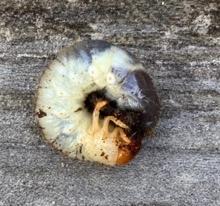Grubs
-
AboutMasked chafers are also called white grubs. They are beetle larvae, white with brown head, up to one inch long with bristles on underside. Produce one generation each year and overwinter as mature larvae. In spring and early summer, they pupate three to six inches deep in the soil.
 Photo by Erin Mahaney, UC Master Gardener
Photo by Erin Mahaney, UC Master Gardener -
CategoryInsect
-
Signs/Symptoms
The most severe injury to plants is caused by large grubs feeding on plant roots in the fall and spring. Grubs feed on roots of weeds, vegetables, and ornamental plants.
The adult beetles (called scarab beetles, May beetles, or June bugs) are about one-half inch long and are golden brown with a darker brown head.
-
Where
Grubs are in the soil.
-
When
When plants start to grow. The adults are attracted to lights at night in the summer, mostly from mid-June through July.
-
Prevent
Be careful when it comes to amending the soil in your beds with fresh compost, because it could contain masked chafer eggs. The larvae (grubs) will locate and feed on roots after they hatch. Before applying compost, be sure it has been properly prepared with sufficient heat to decompose the organic material and to kill insect eggs and other organisms.
-
Manage
Removal is the first line of defense and hand-picking is the best approach.
You can also get help from birds and other predators by turning over the soil to expose the grubs.
Beneficial nematodes are tiny, usually microscopic roundworms that can be applied to control caterpillars or grubs. Nematodes move within moist soil and enter a suitable host. The nematodes, along with associated bacteria, kill the host within a few days. However, the challenge is that the timing for beneficial nematodes is not optimum. Beneficial nematodes are most effective against white grubs in the summer and early fall and requires soil temperatures above 60 degrees. This may be something to consider as you wrap up your vegetable garden in the late summer.
-
More Information

